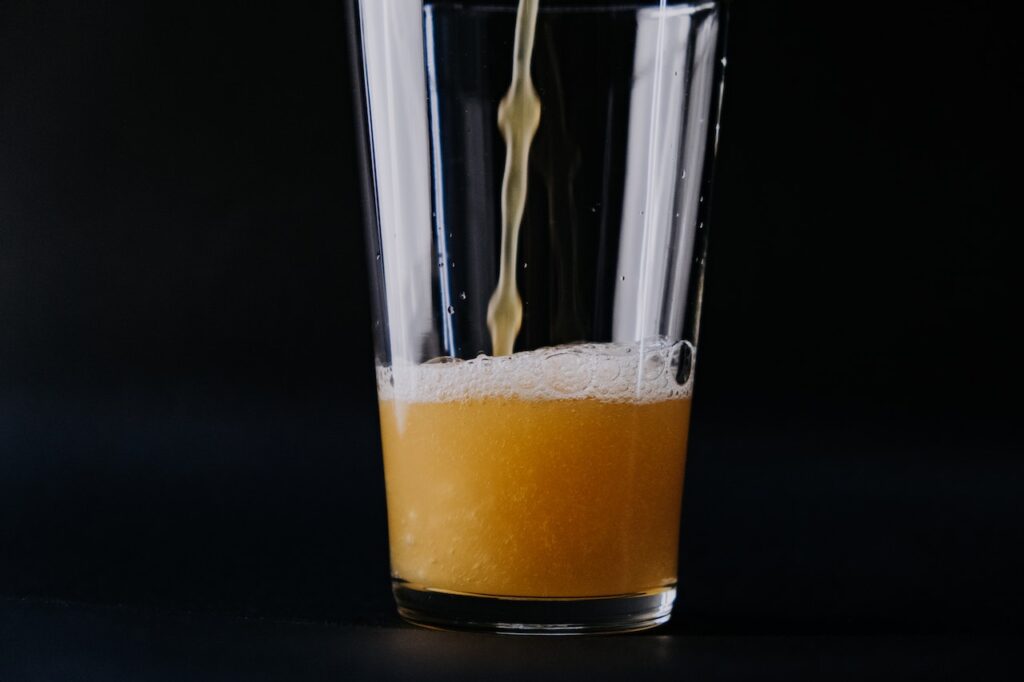If you buy something through a link in our posts, we may get a small share of the sale.
Dry yeast vs liquid yeast is a common debate among brewers. The two types of yeast have similarities and different characteristics that can impact your brewing. The yeast you use can affect your beer’s taste, alcohol content, and carbonation. Therefore it’s vital to choose the right yeast for your recipe.
Contents
Dry Yeast vs Liquid Yeast Overview
Yeast is the backbone of beer. This single-celled organism eats sugar and excretes alcohol, carbon dioxide, and flavor compounds that impact your beer taste. Without yeast, there would be no beer since it’s responsible for fermentation.

Yeast is usually added to the wort, the sweet liquid extracted from grains during the brewing process before fermentation begins. This step is called pitching. Once pitched, yeast begins to consume the sugars in the wort and converts them into alcohol and carbon dioxide.
Yeast comes in two forms: dry and liquid. Both types of yeast have pros and cons that can impact your final product’s flavor, alcohol content, and carbonation. If you are a seasoned brewer, you’ve probably used both types of yeast and have a preference. However, if you are new to brewing, you may wonder which type of yeast is best for your beer recipe and beer-drinking preferences.
Dry Yeast
This dehydrated form of active yeast is easier to store and handle than liquid yeast. It’s a convenient option for brewers since it has a longer shelf-life (up to 3 years) and is less likely to be contaminated. The yeast ships and stores easier since it doesn’t need to be refrigerated or packed in an ice-filled cooler. This makes it more viable since you can store it at room temperature until subsequent use.
The yeast is also packed with nutrients that help it to start fermenting quickly. When rehydrated, this yeast can start fermenting within minutes. This is a significant advantage if you are brewing on a tight schedule. It also contains a higher cell count of 200 billion cells per gram, which can be helpful if you are brewing a high-gravity beer.
Dry yeast is pitched directly into the wort and doesn’t need rehydration first. However, some brewers prefer to rehydrate their yeast in water or wort before pitching to help ensure that the yeast is healthy and active. This step is especially important if you are using an older packet of this yeast or pitching in a high-gravity wort. The yeast can also be blended with other yeast strains to create a unique flavor profile.
Advantages
- The yeast is easy to store and handle
- It is packed with nutrients that help it to start fermenting quickly
- The yeast has a higher cell count( 200 billion) than liquid yeast( 100 billion). This can be helpful if you are brewing a high-gravity beer
- The yeast can be pitched directly into the wort without rehydrating first
- This yeast has a longer shelf-life than liquid yeast( up to 3 years)
Disadvantages
- The yeast can be more challenging to control since it is less stable and can produce unpredictable results
- The yeast can be more challenging to manage when pitching in a high-gravity wort since it can be less active
- It can be challenging to get the correct measurement of the yeast since it comes in solid form and can be clumped together
Liquid Yeast
This fresh form of yeast is perishable and needs to be used within a few weeks of being brewed. It also requires refrigeration and must be shipped in an ice-filled cooler to ensure it arrives alive and healthy. The yeast is available in various strains that can impact the beer’s flavor, alcohol content, and carbonation. This characteristic makes it popular among commercial and experienced brewers who want to create a specific flavor profile.

The shorter life of 3 months makes this yeast more sensitive than dry yeast and can be challenging to control. This is because this yeast is a live microbial culture constantly changing and evolving. The yeast is also more susceptible to contamination since it is in a liquid form and can be easily contaminated by other bacteria and wild yeast.
Most of this type of yeast is packed in a vial or smack-pack (100 billion cells per pack), an airtight container that keeps the yeast alive and healthy. The small packing means that the yeast requires a yeast starter to increase the cell count before it can be used. This is because the yeast will not reproduce in the wort and needs a high cell count to ferment correctly. A starter also allows brewers to check the health of the yeast before using it.
Advantages
- The yeast is available in various strains that can impact the beer’s flavor, alcohol content, and carbonation
- The yeast is packed in a vial or smack-pack, an airtight container that keeps the yeast alive and healthy
- It is easy to make a yeast starter with this type of yeast since it is in a liquid form
- The yeast is always fresh, making it ideal for commercial brewers who want to create a specific flavor profile
Disadvantages
- The yeast is perishable and has a shorter shelf-life of 3 months
- It is more difficult to control since it is a live microbial culture constantly changing and evolving
- The yeast is more susceptible to contamination since it is in a liquid form
Comparison Between the Two
With many details concerning the two types of yeast, it is now possible to compare them side by side so that a more informed decision can be made concerning which is better for your brewing needs.
Similarities
- Both of them are ideal for brewing any kind of beer
- Both types of yeast are available in various strains that can impact the beer’s flavor, alcohol content, and carbonation
- Both types of yeast need to be stored in a cool and dry place to maintain freshness
- Both need a yeast starter where increased cell counts are used in brewing
Differences
- Dry yeast is easier to store since it has a longer shelf-life of up to 3 years compared to liquid yeast, that only has a shelf-life of 3 months
- Liquid yeast is available in more strains than dry yeast, giving brewers more control over the final flavor of their beer
- Dry yeast has 200 billion cells per gram, while liquid yeast has 100 billion per pack
- Dry yeast is less susceptible to contamination since it is in a dry form, while liquid yeast is more susceptible to contamination since it is in a liquid form

Major Distinguishing Factor
The major distinguishing factor between the two types of yeast is the shelf-life. Dry yeast has a shelf-life of up to 3 years, while liquid yeast only has a shelf-life of 3 months. This makes dry yeast easier to store and less likely to go bad.
When to Use Dry Yeast
The best time to use this yeast is when you need a long-term storage option or when you want to make a batch of beer in a shorter amount of time. The yeast is also less susceptible to contamination, making it a good option for home brewers who want to avoid any potential problems.
When to Use Liquid Yeast
The best time to use this yeast is when you want more control over the final flavor of your beer. This is because more strains are available, allowing brewers to create a specific flavor profile.
Which One Is Better Between the Two?
The better option here is dry yeast because it is easier to store, has a longer shelf-life, and is less susceptible to contamination. However, if you want more control over the final flavor of your beer, then liquid yeast is the better option.
Conclusion
The two types of yeast are both used in brewing beer. However, there are some characteristics you should know about each type before deciding which is best for your needs. Ensure you store the yeast in a cool and dry place to maintain freshness. Happy brewing!

